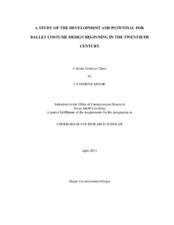| dc.description.abstract | Beginning with the twentieth century, ballet costume design experienced a major shift. The tutu and rigid formwork of classical ballet made way for vanguard experimentation. From world of art to symbolism then futurism, cubism, and modernism among others, progressive shifts in aesthetic ideals followed the major artistic movements of the day. World Wars and Russian revolutions made impacts on the subject matter and extremity of these experiments. After the chaos caused by the wars, there was some natural reversion to the classical style as people yearned for order and the peace they had once had. This reversion was finalized in Russia by a mandate from Stalin in 1932. The rest of Europe suffered a cut in productions because of the wars and witnessed New York rise as the new cultural and artistic center of the world as many artists fled Paris to avoid the violence and find work.The focus of this research is on why the tutu has remained the preeminent costume of ballerinas for so long and whether or not this adherence to classicism is a justified design choice. To begin the research, the history of ballet costumes, predominately in Russia and Russian ballet companies, is analyzed and compressed into a generalized timeline that shows when major art movements and world events took hold and how they influenced ballet costumes. From this research, it is seen why design decisions were made and if those choices were made for reasons still applicable today, such as the dancer‟s ability to move, or if the original reason has long since become a mute issue. Based on the results of this research, a new costume was designed for the swan queen in Swan Lake. This character is chosen because she is timeless and always appears similarly clad. The new design takes into account the reasoning behind the tutu and pushes the tutu forward into a new dimension. | en |


